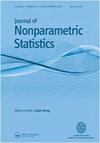使用部分排序数据的模型拟合
IF 0.9
4区 数学
Q3 STATISTICS & PROBABILITY
引用次数: 0
摘要
模型对于完整排名数据的重要性已在文献中得到证实。另一方面,当要排序的对象集合相对较大时,自然会出现部分排序。部分排序产生相容顺序类,保持完全排序。在本文中,我们定义了一个完整排名的指数模型,并基于部分排名数据的随机样本对其进行了校准。我们求助于EM算法。仿真和实际数据验证了该方法的有效性。本文章由计算机程序翻译,如有差异,请以英文原文为准。
Model fitting using partially ranked data
The importance of models for complete ranking data is well-established in the literature. Partial rankings, on the other hand, arise naturally when the set of objects to be ranked is relatively large. Partial rankings give rise to classes of compatible order preserving complete rankings. In this article, we define an exponential model for complete rankings and calibrate it on the basis of a random sample of partial rankings data. We appeal to the EM algorithm. The approach is illustrated in some simulations and in real data.
求助全文
通过发布文献求助,成功后即可免费获取论文全文。
去求助
来源期刊

Journal of Nonparametric Statistics
数学-统计学与概率论
CiteScore
1.50
自引率
8.30%
发文量
42
审稿时长
6-12 weeks
期刊介绍:
Journal of Nonparametric Statistics provides a medium for the publication of research and survey work in nonparametric statistics and related areas. The scope includes, but is not limited to the following topics:
Nonparametric modeling,
Nonparametric function estimation,
Rank and other robust and distribution-free procedures,
Resampling methods,
Lack-of-fit testing,
Multivariate analysis,
Inference with high-dimensional data,
Dimension reduction and variable selection,
Methods for errors in variables, missing, censored, and other incomplete data structures,
Inference of stochastic processes,
Sample surveys,
Time series analysis,
Longitudinal and functional data analysis,
Nonparametric Bayes methods and decision procedures,
Semiparametric models and procedures,
Statistical methods for imaging and tomography,
Statistical inverse problems,
Financial statistics and econometrics,
Bioinformatics and comparative genomics,
Statistical algorithms and machine learning.
Both the theory and applications of nonparametric statistics are covered in the journal. Research applying nonparametric methods to medicine, engineering, technology, science and humanities is welcomed, provided the novelty and quality level are of the highest order.
Authors are encouraged to submit supplementary technical arguments, computer code, data analysed in the paper or any additional information for online publication along with the published paper.
 求助内容:
求助内容: 应助结果提醒方式:
应助结果提醒方式:


